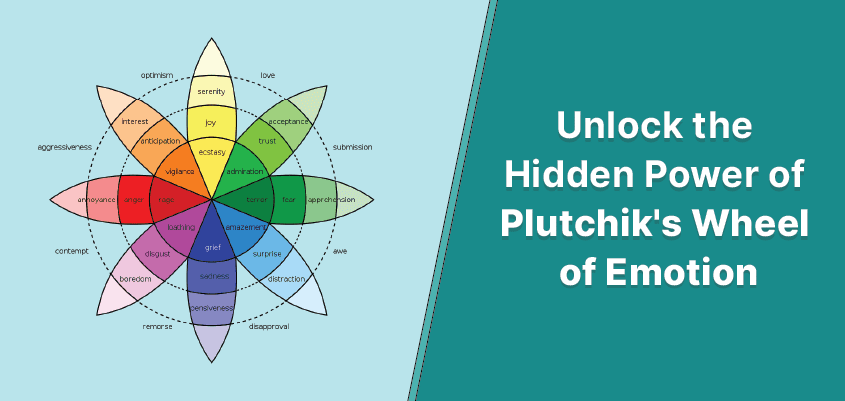Introduction
Human beings experience a range of emotions in a day. They change rapidly and affect an individual greatly. At times, multiple emotions can occur together and it can be difficult to identify what one is going through. Psychologists often help people identify their emotions using tools and techniques. This article explores one such tool called the Plutchik’s wheel of emotion.
What is Plutchik’s Wheel of Emotion?
Plutchik’s Wheel of Emotion is a model of emotions that shows how different feelings are related to each other. Developed in the 1980s by Robert Plutchik, this model is based on the theory of emotions by Plutchik.
This theory considered that emotions helped in survival of a species and are like feedback to the environmental changes happening around an organism [1]. For instance, fear could help in making an animal withdraw from a threatening situation [2]. Further, in human society, certain emotions may help in social regulation. For instance, shame would make the person avoid acting in a certain manner again and again [2].
Plutchik identified 8 basic emotions and noted that all other emotions are combinations of these. Further, he conceptualized that these emotions can have different intensities and are placed in a manner that they have opposites (ex: sadness vs joy) [1]. The eight basic emotions are: joy, trust, fear, surprise, sadness, disgust, anger, and anticipation.
The model has the following components [1] [2] [3]:
- Relation between emotions: The 8 primary emotions are placed in circle sectors. The circle sectors are placed in a manner that similar emotions are placed together and opposite emotions are shown 180° to each other. The colour palette is chosen in a way that complimentary colors show opposite emotions.
- Mixture of emotions: The model also mentions emotions which are made by combining two primary emotions. For example: joy and trust combine to form love.
- Intensity of emotions: The model actually becomes conical when the vertical dimension of intensity is added. The emotions in the middle are the most intense and as they go out, they become less intense and more cognitive.
The model captures the range of human emotions in a concise manner and also brings to notice that at any given point a person can experience multiple emotions.
Why was Plutchik’s Wheel of Emotion Created?
Ever since scientific research has begun, there has been a great deal of uncertainty around the phenomenon of emotions. According to one estimate there are more than 90 definitions of the term emotion [2]. One such definition considers emotions to be the feeling aspect of consciousness which has 3 elements, namely, physical sensation, a behavior, and inner awareness that one is feeling something [4, p.371].
Plutchik was interested in developing a framework that could help people identify and differentiate between different types of emotions. He drew on his research from various fields to develop a model that could explain the many different emotions that humans experience. He also noted that the English language had many words for emotions and this model helped in organizing these words to reveal relationships between different emotions [2].
Emotions have a function and motivate people to perform a certain way. A stronger emotion will have a stronger influence on a person. Since the model captures the complex human experience of emotions and thus, helps in furthering the understanding of this experience.
How to use Plutchik’s Wheel of Emotion
One of the central skills in Emotional intelligence is the ability to identify which emotion a person is experiencing. This requires a vocabulary of the range of emotions that exist in humans [3]. Plutchik’s Wheel of Emotion is a useful tool for this.
The first step is to become familiar with the structure and the dimensions given on the wheel. Some websites such as sixseconds [3] have an interactive model of the wheel which helps in understanding it more deeply.
A person can then become aware of what they might be feeling by using the wheel to identify their emotions. They can also notice the intensity of emotions they are experiencing. It is useful to remember that at one given point a person experiences many emotions. Thus, when using the wheel, asking questions like “what else am I feeling?” a few times can help. Identification of emotion can be followed by reflection on what might be causing a person to feel a certain way.
Often, using Plutchik’s Wheel of Emotions is about practice. Users can consider creating a routine where they spend some time becoming aware about their emotions and plotting them on the wheel during a day. This can be clubbed with practices like mindfulness to help gain more insight into one’s experience.
Experts on emotions, such as psychologists and life coaches can also help a person in learning how to use this tool along with others to enhance emotional awareness. The United We Care platform enlists many experts who can help in this endeavor.
Benefits of Plutchik’s Wheel of Emotion
This model has been used extensively in psychotherapy, training, and research ever since it has originated. There are many benefits of Plutchik’s Wheel of Emotion. These include:
- Enhancing Emotional Awareness: The model enhances the understanding of subject matter of emotions. It gives insight into what different emotions are and how they are related to each other [3]. Thus the user becomes more aware of what they are experiencing.
- Emotional Regulation: Often becoming aware of emotions and their intensity allows an individual to develop strategies to control them. It also allows a person to communicate exactly what they are feeling to others.
- Enhancing Empathy: The model is also used in identifying emotions in others. Thus, users of the wheel can become more empathetic by practicing the skill of identifying emotions in others.
- Training in Emotional Intelligence: Trainers across the world have used this model to explain concepts to emotions to managers, leaders, students etc. Since the model explains emotions in a concrete manner, trainees are able to enhance their emotional intelligence.
- Market research and sentiment analysis: Some researchers are now using the tool to check responses of people on certain products [5]. This can help companies improve what they offer and make effective business decisions.
Conclusion
Plutchik’s emotion wheel is an ingenious tool which provides a comprehensive understanding of human emotions, their relation between each other and the intensity that they can have. Using the tool can help individuals in identifying and expressing emotions, enhancing emotional intelligence and even assisting companies in emotionally appealing products and messages.
Are you on a journey of self discovery, reach out to our experts or explore more content at United We Care ! At United We Care, a team of wellness and mental health experts will guide you with the best methods for self discovery and well-being.
References
- Y. Zheng and B. Ju, “Emotions and Mental Health: A Comparative Examination of Traditional Chinese Medical Theories of the Mind and Robert Plutchik’s Wheel of Emotions,” International Conference on Studies in Education and Social Sciences (ICSES), pp. 201–211, Nov. 2021. doi:10.32629/jcmr.v2i4.550
- R. Plutchik, “The nature of emotions,” American Scientist, vol. 89, no. 4, p. 344-350, 2001. doi:10.1511/2001.28.344
- Six SecondsSix Seconds supports people to create positive change – everywhere… all the time. Founded in 1997, “Plutchik’s wheel of emotions: Feelings wheel,” Six Seconds, (accessed May 10, 2023).
- S. K. Ciccarelli, in Psychology, Hoboken, NJ: Pearson Education, 2020, p. 371
- D. Chafale and A. Pimpalkar, “Review on Developing Corpora for Sentiment Analysis Using Plutchik’s Wheel of Emotions with Fuzzy Logic,” International Journal of Computer Sciencesand Engineering and Engineerin, pp. 14–18, Oct. 2014.











